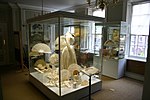Royal Hill, Greenwich

Royal Hill, Greenwich is a mainly residential street, approximately 0.7 km (0.4 mi) long, in Greenwich in South London. It runs uphill off Greenwich High Road in a southwards curve and then westwards to meet Greenwich South Street. At the northern end of the road is Greenwich Town Hall, a 1939 Art Deco building designed by Clifford Culpin. A number of Georgian era houses are located along the road. The Pevsner Guide describes much of the road as "the usual suburban expansion" which was "filling in between the more scattered eighteenth century houses". Royal Hill was once the name of the entire hill rather than just the street, and so other roads in the area are historically referred to as Royal Hill, including Point Hill which ascends south towards Blackheath.
Excerpt from the Wikipedia article Royal Hill, Greenwich (License: CC BY-SA 3.0, Authors, Images).Royal Hill, Greenwich
Royal Hill, London East Greenwich (Royal Borough of Greenwich)
Geographical coordinates (GPS) Address Nearby Places Show on map
Geographical coordinates (GPS)
| Latitude | Longitude |
|---|---|
| N 51.47666 ° | E -0.00944 ° |
Address
Royal Hill 46
SE10 8RT London, East Greenwich (Royal Borough of Greenwich)
England, United Kingdom
Open on Google Maps







